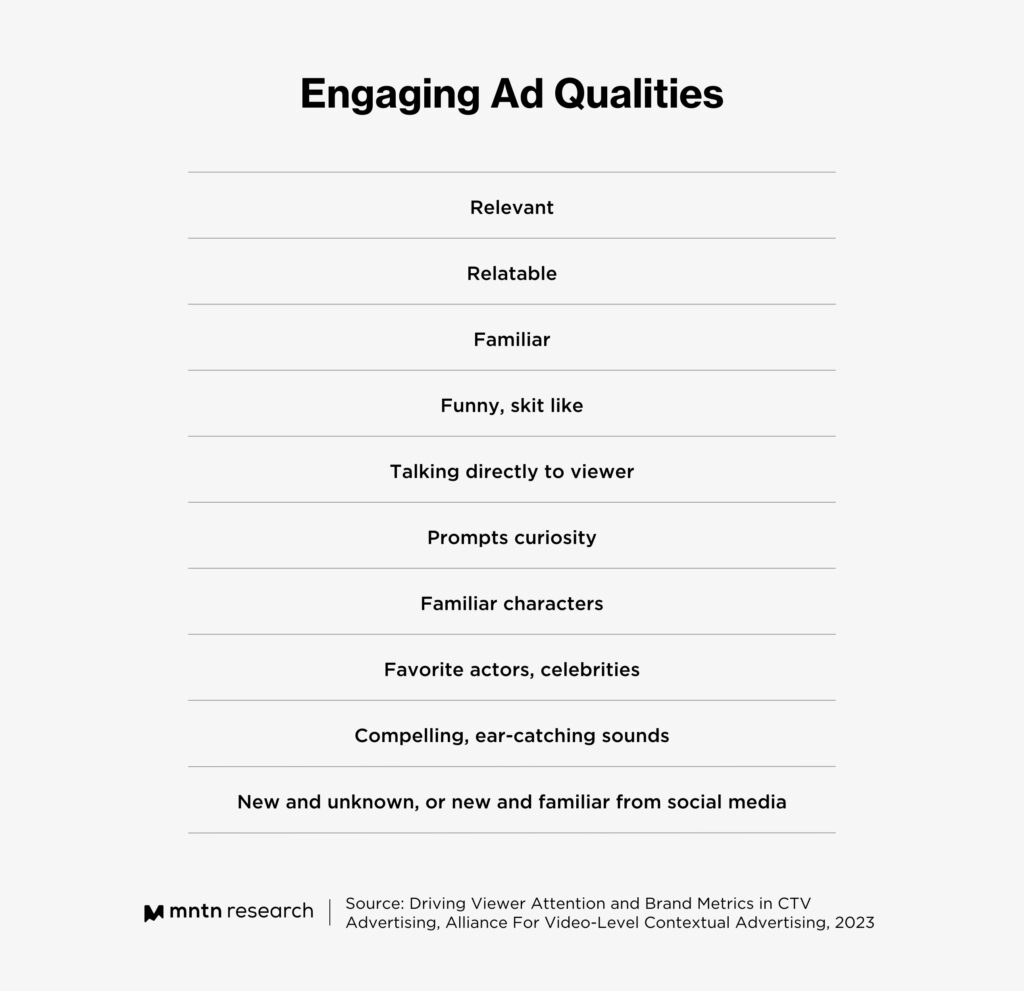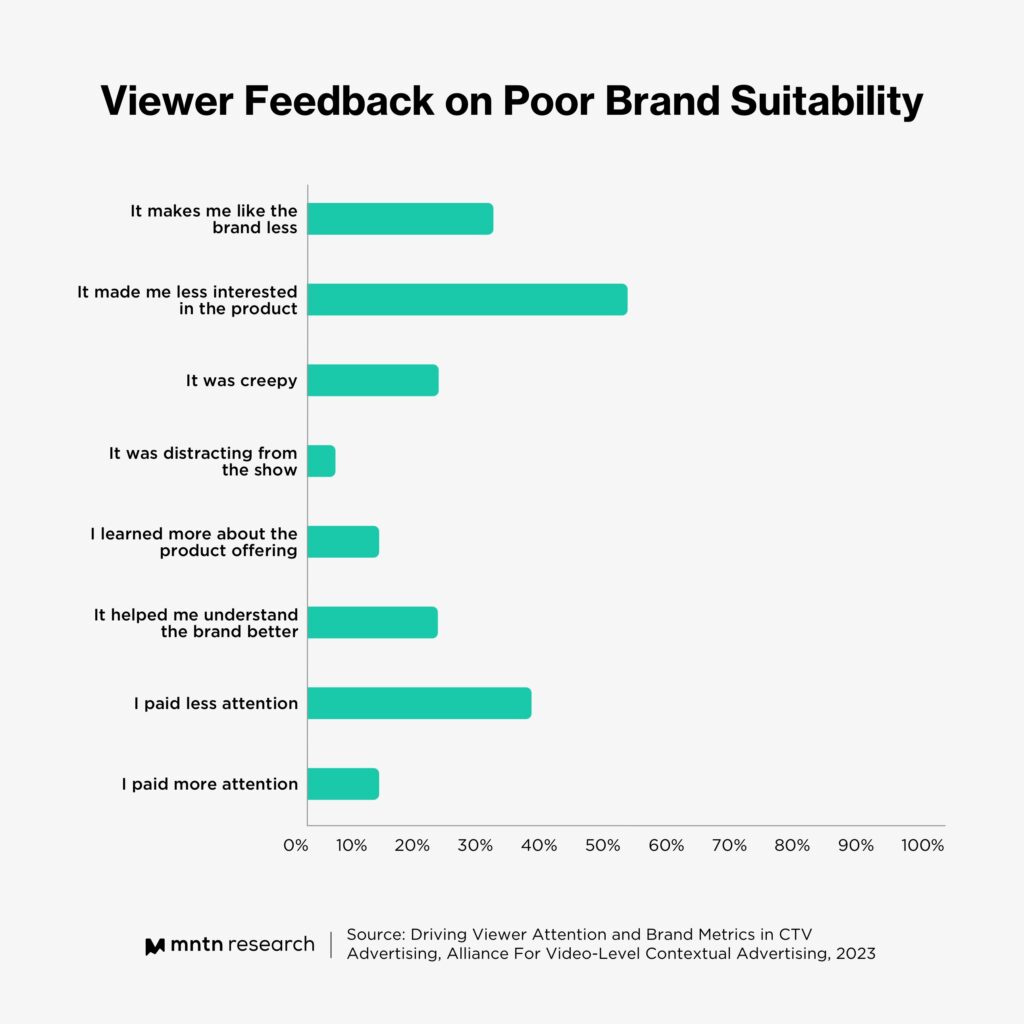Research Digest
Curating Context: An Analysis of Brand Favorability and Connected TV Ads
by Melissa Yap4 min read
Abstract
- A consumer research study by AVCA (Alliance For Video-Level Contextual Advertising) highlighted Connected TV ad qualities that were more conducive to increasing engagement, and significantly enhanced the performance of programmatic TV campaigns.
- CTV viewers are highly sensitive to irrelevant content and unsuitable ad placements, which not only reduced attention but gave off a negative perception of the brand.
- Overall, 54% of viewers were less interested in the product, while 31% liked the brand less when they were served an ad that was contextually misaligned.
“In addition to being able to find people wherever they are, it’s incredibly important that [brands] understand where their ads are running, because that’s going to have a direct impact [for business outcomes] and a long-term impact on brand perception.” So says Rohan Castelino, a principal member of the Alliance for Video-Level Contextual Advertising (AVCA), an organization that advocates for both the audience and publisher side to ensure that ad-supported streaming offers both the best experience for viewers and the best value for publishers and brands.
AVCA conducted their inaugural survey with a small panel of 24 households that regularly watched and supported streaming TV. Altogether, these households watched over 1,000 ad experiences on their smart TVs; they had access to whatever other household devices (i.e. smartphones) they’d usually have when watching TV. This breakdown dives into the findings relevant to brands and CTV advertisers looking to improve their approach in 2024.
Which Ad Qualities Top the List?
Not all ads are created equally. While it’s generally believed that ad breaks disengage users, certain elements can actually increase engagement. AVCA’s study revealed the stand-out qualities that advertisers should consider when building their creative.

The study found ad performance improved when there was a higher relevance between ad and show, as it felt more curated and a more seamless experience. Additionally, this revealed another benefit: ads were engaging even if the product wasn’t relevant to the viewer — when the ad felt appropriate for the content, the viewer would remember the product and bring it up in conversation later on.
What Happens When an Ad Is Misaligned?
The 24 household respondents — who comprised a nationally representative panel — categorized 20% of the study’s 1000 ads as contextually misaligned, disrupting the ad experience and leaving a negative impression of brands overall.

The top two bits of feedback focused on interest and attention: 54% of viewers were less interested in the product, while 31% liked the brand less when they were served an ad that was contextually misaligned.
When Does Context Harm Instead of Help?
Let’s look at two of the ads from the study. One was a fact-driven pharmaceutical ad, served alongside a comedy show with a scene that satirized a serious disease. The other ad was a public service announcement, aired during a scene depicting characters engaged in violent and aggressive behavior. The creative in the latter ad used values-driven dramatization to show the dangers of road rage. Both instances left viewers unsettled. “It confuses the viewers who are just trying to watch a funny show,” said one panelist. “I do not remember the brand and tuned them out.”
Instead of trying to match ad creative to programming and running into these programming conflicts, brands are better served thinking about who they are trying to target, and keep this front and center when creating their CTV ad.
Why Advertisers Should Apply an Audience-First Approach to Their CTV Campaigns
Household brands and agencies have found great success through this audience-first approach. One example is San Diego founded agency ATTN, who prioritized this approach for one of their clients by splitting out CTV campaigns across multiple audience groups. This generated a 42% increase in gross revenue, 28% increase in total conversions, and a 9% increase in average order value. Additionally, this approach fueled their performance marketing engine, and helped to drive down CPMs versus their other performance channels like paid search.
While there’s much value in aligning your ad to a specific show and filling your ad creative with engaging ad features, the findings from AVCA’s study revealed that even an exciting commercial can backfire in the wrong context. This is why we recommend an audience-first approach above all. Advertisers can take an extra step by applying blacklists to identity networks where they wouldn’t want your CTV ad running, which mitigates any context issues that may arise. Ultimately, each viewer is different, with their own likes and dislikes, and an audience-first approach takes into account these nuances and serves CTV ads to the audiences that are likely to resonate with your brand message — no matter what show they may be watching.
Subscribe to the MNTN Research Weekly
Sign up to receive a weekly feed of curated research, sent straight to your inbox.
Resources
1 Driving Viewer Attention and Brand Metrics in CTV Advertising (Alliance For Video-Level Contextual Advertising)